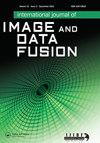A segment-based filtering method for mobile laser scanning point cloud
IF 1.8
Q3 REMOTE SENSING
International Journal of Image and Data Fusion
Pub Date : 2022-03-06
DOI:10.1080/19479832.2022.2047801
引用次数: 3
Abstract
ABSTRACT In most Mobile Laser Scanning (MLS) applications, filtering is a necessary step. In this paper, a segmentation-based filtering method is proposed for MLS point cloud, where a segment rather than an individual point is the basic processing unit. In particular, the MLS point clouds in some blocks are clustered into segments by a surface growing algorithm, and then the object segments are detected and removed. A segment-based filtering method is employed to detect the ground segments. The experiment in this paper uses two MLS point cloud datasets to evaluate the proposed method. Experiments indicate that, compared with the classic progressive TIN (Triangulated Irregular Network) densification algorithm, the proposed method is capable of reducing the omission error, the commission error and total error by 3.62%, 7.87% and 5.54% on average, respectively.一种基于分段的移动激光扫描点云滤波方法
摘要在大多数移动激光扫描(MLS)应用中,滤波是一个必要的步骤。本文针对MLS点云,提出了一种基于分割的滤波方法,其中以分段而非单个点为基本处理单元。特别地,通过表面生长算法将某些块中的MLS点云聚类成片段,然后检测并去除对象片段。采用基于分段的滤波方法来检测地面分段。本文的实验使用了两个MLS点云数据集来评估所提出的方法。实验表明,与经典的渐进式不规则三角网加密算法相比,该方法能够将遗漏误差、委托误差和总误差分别平均降低3.62%、7.87%和5.54%。
本文章由计算机程序翻译,如有差异,请以英文原文为准。
求助全文
约1分钟内获得全文
求助全文
来源期刊

International Journal of Image and Data Fusion
REMOTE SENSING-
CiteScore
5.00
自引率
0.00%
发文量
10
期刊介绍:
International Journal of Image and Data Fusion provides a single source of information for all aspects of image and data fusion methodologies, developments, techniques and applications. Image and data fusion techniques are important for combining the many sources of satellite, airborne and ground based imaging systems, and integrating these with other related data sets for enhanced information extraction and decision making. Image and data fusion aims at the integration of multi-sensor, multi-temporal, multi-resolution and multi-platform image data, together with geospatial data, GIS, in-situ, and other statistical data sets for improved information extraction, as well as to increase the reliability of the information. This leads to more accurate information that provides for robust operational performance, i.e. increased confidence, reduced ambiguity and improved classification enabling evidence based management. The journal welcomes original research papers, review papers, shorter letters, technical articles, book reviews and conference reports in all areas of image and data fusion including, but not limited to, the following aspects and topics: • Automatic registration/geometric aspects of fusing images with different spatial, spectral, temporal resolutions; phase information; or acquired in different modes • Pixel, feature and decision level fusion algorithms and methodologies • Data Assimilation: fusing data with models • Multi-source classification and information extraction • Integration of satellite, airborne and terrestrial sensor systems • Fusing temporal data sets for change detection studies (e.g. for Land Cover/Land Use Change studies) • Image and data mining from multi-platform, multi-source, multi-scale, multi-temporal data sets (e.g. geometric information, topological information, statistical information, etc.).
 求助内容:
求助内容: 应助结果提醒方式:
应助结果提醒方式:


